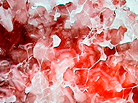replikantki (1) — znieczulenie — Dorota Buczkowska „Lilith”, „Interror”, …

„Replikantki” to cykl wystaw w Małej Przestrzeni prezentujący twórczość młodych polskich artystek. Tytułowe określenie ma wpisany w siebie rewolucyjny potencjał, generowanie nieznanych wartości, odwracanie przeciwko systemowi, który je stworzył. Miarą prawdziwości przywołanych historii staje się niezgoda na sformatowanie do racjonalnych ram i sztywnych, logicznie uzasadnionych podziałów, potrzeba mocnego upodmiotowienia kobiety-autorki w strategiach lektury. Odkrywanie sensu tkwiącego w szczególe staje się bazą do stworzenia nowego języka, w którym artystki nie występują w roli outsiderów, ale znajdują miejsce dla mówienia o sobie, w pewnym przesunięciu do obowiązującego fallogocentrycznego porządku. Sięgając do intymnych doświadczeń zatracają się w tekstach, rozłożone w toksycznych wydzielinach własnej sieci.

„Replikantki” — intymne przekazy artystek (teksty, prace, idee) skumulowane w publikacji Książka została zaprojektowana jako dokumentacja cyklu wystaw, który odbywał się w Galerii Sztuki Współczesnej BWA w Katowicach w...

replikantki (4) — język do lizania — Justyna Gruszczyk i Bianka Rolando Joseph Beuys w jednej ze swoich legendarnych akcji szepce coś do ucha martwego zająca, którego nosi na rękach. Nie wiadomo co mówi. Zgodnie...

replikantki (3) — minimalne poprawki — Alicja Karska i Aleksandra Went Prace Aleksandry Went i Alicji Karskiej wydają się oporne w swojej prostocie, szczelnie zamknięte. Tak jak w przypadku snów, co do...

replikantki (2) — cieplarniane warunki — Natalia Bażowska, Kinga Bella, Magdalena Starska, Tatiana Wolska Drążenie autorskich wizji oprócz precyzyjnych narzędzi wymaga cierpliwości i uwagi, jeśli lektura jest przeprowadzana z biegu wytraca sens....

Znieczulenie znosi świadomość, ból i odruchy obronne. Jako zabieg wynika z potrzeby utwardzania, ochrony przed zbyt intensywnymi doznaniami. Może być rozumiane jako obojętność, wycofanie, brak czucia.
Video Doroty Buczkowskiej osłabiają połączenia nerwowe, spowalniają ruchy i zostawiają na ciele ledwo widoczne inskrypcje, ślady obcości i bezwładu w postaci mrowienia. Działają jak drobne ukąszenia i ukłucia, z których wykwitają niespodziewanie duże sińce.
Na jednym z video spod warstewki śniegu wynurza się rozedrgana krwawa kałuża, na drugim igła wbija się w skórę pozostawiając na jej powierzchni czerwoną kropkę. Dystans spowodowany wyolbrzymieniem tych procesów obserwowanych na co dzień, przez co prawie niezauważalnych, wywołuje uczucie odrętwienia i paniki. Prostota pomysłu zawiera w sobie szczególną ostrość. Igła dziurawi sprężynującą powierzchnię skóry, biel lodu przechodzi w mięsną, bulgocącą substancje. Pełne napięcia momenty, na które Buczkowska zwraca uwagę, wymykają się łatwym interpretacjom. Obserwuje się je jak słoik trujących konfitur o zachęcającym rubinowy kolorze. Kiedy w środku zachodzą dynamiczne procesy fermentacji i przemian, z zewnątrz widać tylko drobne, przemieszczające się pęcherzyki powietrza. Trudne do zidentyfikowania niebezpieczeństwo wisi w powietrzu.
Video „Lilith” jest rejestracją zbliżenia na granicy rozkoszy i gwałtu. Przesunięcie dźwięku i obrazu wywołuje u widza dyskomfort. Brakuje stabilnej perspektywy. Spojrzenie ślizga się po fragmentach zarejestrowanej sytuacji. Rozmyty obraz drażni. Nie wiadomo ile osób bierze udział w tej scenie, a ile jej się przygląda, skąd dochodzą złowieszcze śmiechy i co je spowodowało? Odurzona bohaterka, której głowa zostaje ukryta poza kadrem, eksponuje bezwładne, blade ciało, miejscami zaczerwienione, jeszcze ciepłe od snu. Oczy są zamknięte. Bohaterka jest wewnątrz. Zanurza się w czuciu. Jej przyspieszony oddech wydaje się być spowodowany nienaturalnym wysiłkiem albo ruchem, w który włożyła wszystkie siły. Brak eksponowania samej twarzy może być gestem odcięcia się od racjonalności, zwrotem w stronę szaleństwa równoznacznym z pozbawieniem bohaterki tożsamości i głosu. Niemożność wypowiedzenia pragnienia jest jednocześnie jego brakiem.
Słowo użyte w tytule pracy „Interror” nie istnieje w języku polskim ani w żadnym innym, jednak wydaje się znajome. Stoi blisko nie tylko pojęcia terror, ale i interior niosącego w sobie obietnicę niespodzianki oznaczenia dla trudno dostępnego terytorium położonego w głębi kraju. „Interror” to instalacja przypominająca kształtem gniazdo owadów przyklejone na ścianie. Na wystawie tym zbitym w narośla, kruchym prochowo-parafinowym kulom towarzyszy dokumentacja procesu przygotowywania. Alchemiczne konotacje rejestrowanej przez Buczkowską sytuacji związanej z materiałami, których używa do przyrządzenia wybuchowych skorup, powodują u widza stan nieprzyjemnego napięcia. Terrorystyczne działanie zakładające totalne zniszczenie nie licuje z wysmakowanym wizualnie obrazem stylizowanym na „Mleczarkę” Vermerra. W zaciszu domowego laboratorium artystka pochyla się nad foremkami, odmierza i łączy składniki. Gesty jej dłoni w gumowych rękawiczkach są oszczędne i spokojne, jak ruchy pielęgniarki dobrze znającej swój fach. Miękkie oświetlenie sceny i żmudny proces wymagający skupienia, sprzyja sielankowej atmosferze, którą artystka rozbija zachowując się jak sabotażystka. Jej plany wydają się bezlitosne i okrutne, są przeprowadzane na zimno jak zemsta za nieznane widzowi krzywdy. W czasie, który mogłaby poświęcić na pożyteczne czynności, Buczkowska w ukryciu przygotowuje bomby. Jednak z niewiadomych powodów zatrzymuje się w połowie drogi i nigdy nie pozwala im wybuchnąć. Jej buntownicze działania wyrastające z niszczycielskich potrzeb pozostają zawieszone. Zagrożenie nagromadza się pod skórą. Okazuje się, że gest wytwarzania/znoszenia kruchych, prochowych jaj we własnym domu najbardziej zagraża samej autorce. Jej terroryzm jest skierowany do wewnątrz. Pozory zostają zachowane. Ładna, miła pani — wszystko dobrze.
Kuratorka: Marta Lisok




